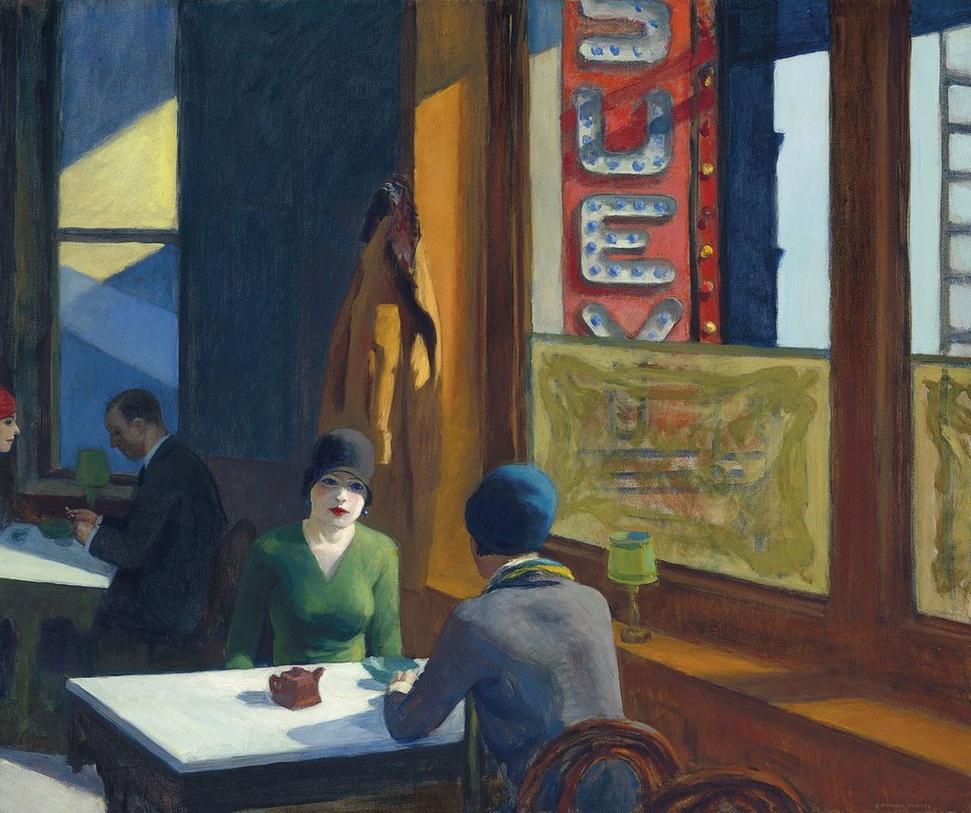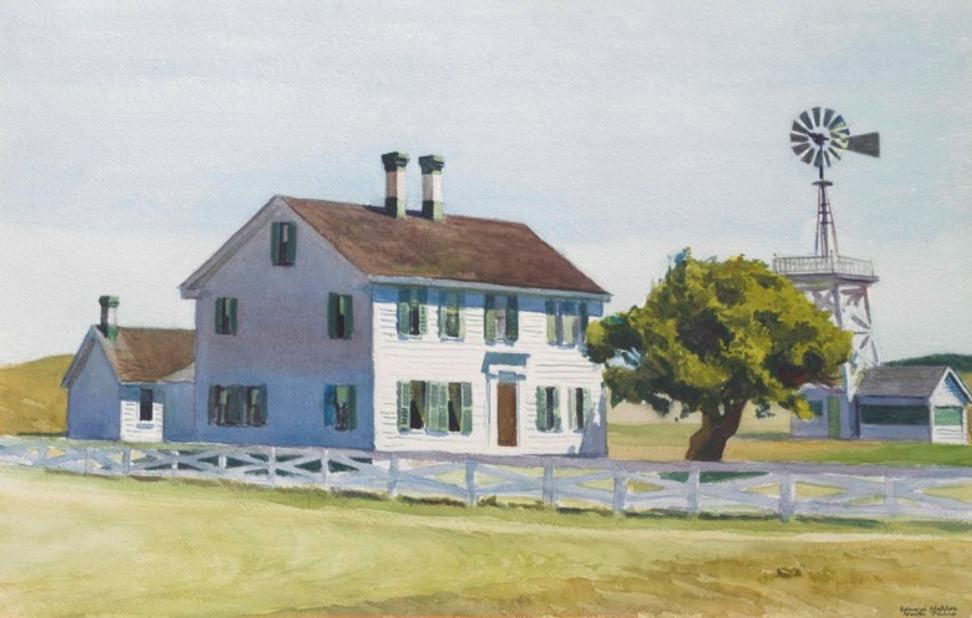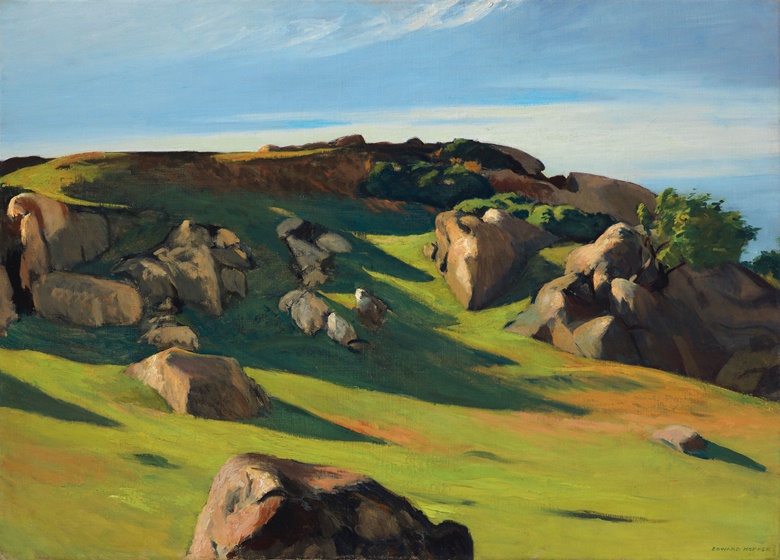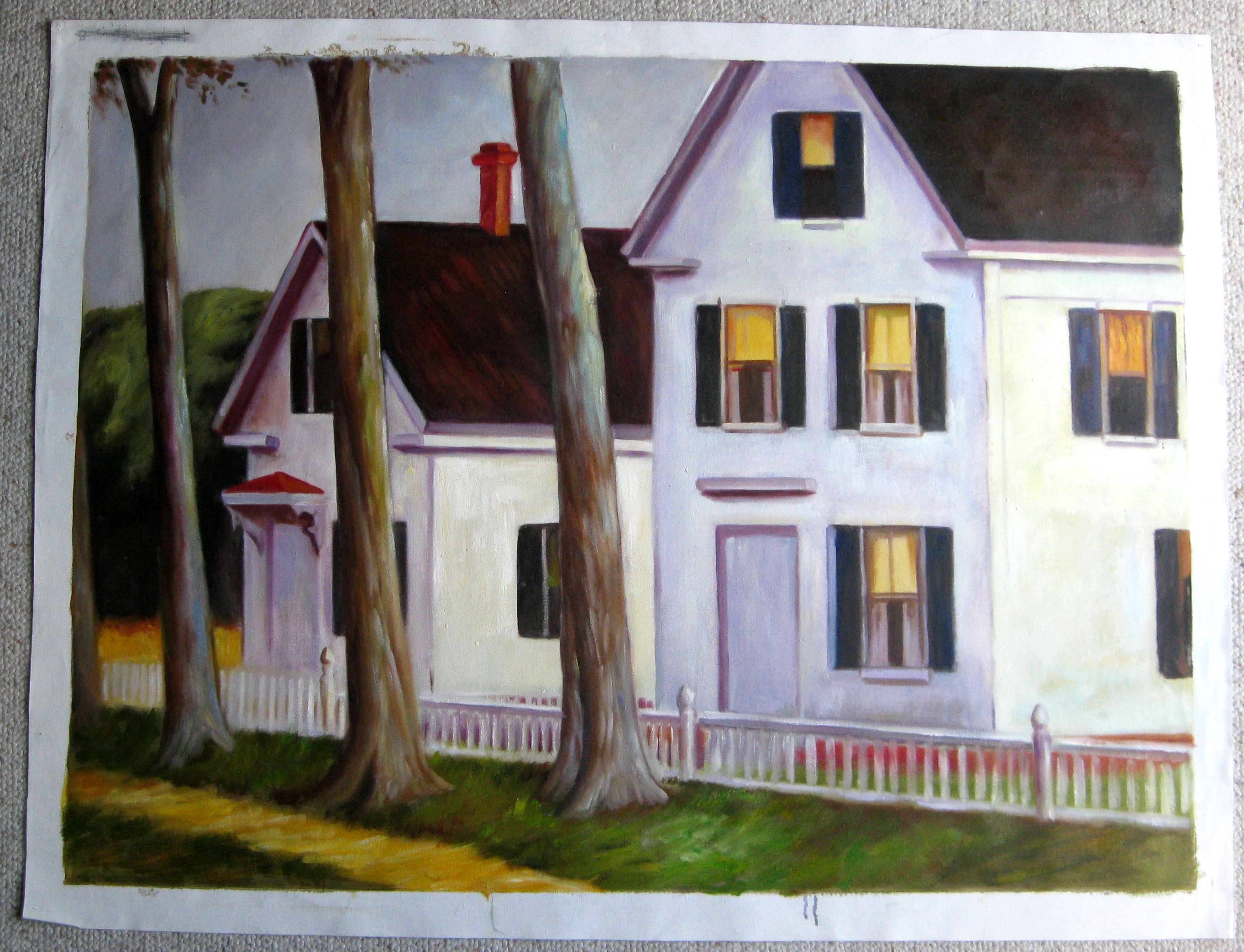Also see Edward Hopper at Auction
Sotheby’s American Art auction in New York on 21 May 2019 is led by Edward Hopper’s Central Park scene, Shakespeare at Dusk (estimate $7/10 million), as well as significant examples by American icons such as Norman Rockwell, Grant Wood, Georgia O’Keeffe, and Mary Cassatt. Highlights from the auction are now on view in Sotheby’s newly expanded and re-imagined New York galleries, with the full exhibition of all works opening on the 17th.EDWARD HOPPER’S SHAKESPEARE AT DUSK
Edward Hopper, Shakespeare at Dusk. Estimate: $7/10 Million. Courtesy Sotheby's.  |
Following the sale of Edward Hopper’s seminal Two Comedians last November, Sotheby’s is offering yet another outstanding work by the artist: Shakespeare at Dusk (estimate $7/10 million). Set in Central Park, this scene belongs to Hopper’s celebrated series of New York cityscapes—a subject matter he explored early in his career while studying under Robert Henri and continued until his death in 1967. Painted in 1935, the work was previously held in the collection of John J. Astor VI, prominent socialite and son of Colonel John Jacob Astor IV, who tragically died in the sinking of the Titanic in 1912.
A lifelong lover of poetry and prose, Hopper overtly references the profound influence of literature on his emotional response to specific times of day, particularly the evening in Shakespeare at Dusk. The poems that he quoted, often as explanations for his own art, frequently focus on the mood of dusk—its sense of mystery, anxiety, and eros born out of the varying effects of light and shadow.
Shakespeare at Dusk depicts two statues cloaked in shadow near a deserted southern end of the Central Park Mall, which is illuminated by the vibrant afterglow of sunset on the horizon. In the foreground, Hopper presents John Quincy Adams Ward’s full-standing sculptural portrait of the celebrated playwright William Shakespeare, with his head bowed in contemplative thought. The inclusion of identifiable modern skyscrapers beyond the park is exceedingly rare in Hopper’s oeuvre and the present work is one of only a few New York scenes where the exact physical location is clearly apparent.
.jpg)
Additional American Modernist highlights include Edward Hopper’s Windy Day which is sold to benefit The Prospect Hill Foundation and depicts the White River in Vermont with the adept handling of watercolor and keen understanding of light for which the artist’s works on paper are best known (estimate: $1,000,000-1,500,000).
Christie’s has announced An American Place: The Barney A. Ebsworth Collection, will be offered in a dedicated evening and day sale in November as a highlight of its flagship 20th Century Week in New York. The collection of Barney A. Ebsworth represents an extraordinary achievement in the history of collecting — a singular assemblage of over 85 artworks that illuminates the rise of American art across the 20th century. Highlights of the collection include Edward Hopper’s Chop Suey, 1929, the most important work by the artist still in private hands (estimate in the region of $70 million), Jackson Pollock’s Composition with Red Strokes (estimate in the region of $50 million) and Willem de Kooning’s Woman as Landscape (estimate in the region of $60 million).
A global tour of highlights will commence in Paris 6-9 September, coinciding with La Biennale Paris, followed by highlight exhibitions in New York, Hong Kong, London, San Francisco and Los Angeles, and culminating with the auction preview at Christie’s Rockefeller Galleries in New York. The tour in Paris will include works by Hopper, Pollock, de Kooning, Kline, Nadelman, Davis, Sheeler, O’Keeffe and Glackens. The collection is expected to realize in excess of $300 million.
Marc Porter, Chairman, Christie’s Americas, commented:
As a tribute to the former Stieglitz gallery, Ebsworth bestowed the name “An American Place” on his home in Seattle, which was built in collaboration with architect Jim Olson and designed as a dialogue between art and architecture. Ebsworth’s credo in collecting was “quality, quality, quality,” and with that mindset he amassed the most comprehensive collection of American Modernism in private hands, with many works having been loaned to leading institutions throughout his years of ownership.

A seminal composition within the landscape of American Modernism, Edward Hopper’s Chop Sueywas one of Mr. Ebsworth’s most prized possessions (estimate in the region of $70 million). Possibly derived from a Cantonese phrase, tsap sui, meaning ‘odds and ends,’ chop suey referred not only to a low-cost stir-fry dish but, moreover, to a public destination where the societal fusion of different cultural elements of the modern city came together.
As in his masterwork Nighthawks (1942, Art Institute of Chicago, Chicago, Illinois), Hopper’s 1929 painting Chop Suey distills the atmosphere of this everyday eatery into a cinematic scene that at once depicts an implicit narrative while creating clear allusions to broader themes of social isolation, gender roles and art historical tradition. While having its roots in the French Impressionist and Ashcan traditions of painting city life, Chop Suey incorporates a thoroughly modern play of light and color to capture a specific restaurant that the Hoppers frequented on the Upper West Side of New York. The most important painting by Hopper left in private hands, Chop Suey epitomizes the psychologically complex meditations for which the artist is best known, while uniquely capturing the zeitgeist of New York during one of its most interesting eras of transition. Chop Suey was included in the groundbreaking retrospective at the Grand Palais in Paris 2012-13, which broke attendance records for the location.
A global tour of highlights will commence in Paris 6-9 September, coinciding with La Biennale Paris, followed by highlight exhibitions in New York, Hong Kong, London, San Francisco and Los Angeles, and culminating with the auction preview at Christie’s Rockefeller Galleries in New York. The tour in Paris will include works by Hopper, Pollock, de Kooning, Kline, Nadelman, Davis, Sheeler, O’Keeffe and Glackens. The collection is expected to realize in excess of $300 million.
Marc Porter, Chairman, Christie’s Americas, commented:
“Last season, Christie’s made the bold move of launching the $835 million Collection of Peggy and David Rockefeller in Asia, underscoring our investment and deep commitment to collectors in this growing region. This season, Christie’s Paris will host the debut of this stunning collection for the global collecting community, positioning it in the heart of Europe and paying homage to Barney A. Ebsworth’s lifelong love affair with the city that first introduced him to great art. His unique journey as a collector resonates with the influence and art historical connections of Gertrude Stein’s Paris, and ultimately set a new high standard for the creation of a nuanced collection of 20thCentury Art that is without parallel in its exceptional depth and quality.”“AN AMERICAN PLACE” – COLLECTION HIGHLIGHTS
As a tribute to the former Stieglitz gallery, Ebsworth bestowed the name “An American Place” on his home in Seattle, which was built in collaboration with architect Jim Olson and designed as a dialogue between art and architecture. Ebsworth’s credo in collecting was “quality, quality, quality,” and with that mindset he amassed the most comprehensive collection of American Modernism in private hands, with many works having been loaned to leading institutions throughout his years of ownership.

A seminal composition within the landscape of American Modernism, Edward Hopper’s Chop Sueywas one of Mr. Ebsworth’s most prized possessions (estimate in the region of $70 million). Possibly derived from a Cantonese phrase, tsap sui, meaning ‘odds and ends,’ chop suey referred not only to a low-cost stir-fry dish but, moreover, to a public destination where the societal fusion of different cultural elements of the modern city came together.
As in his masterwork Nighthawks (1942, Art Institute of Chicago, Chicago, Illinois), Hopper’s 1929 painting Chop Suey distills the atmosphere of this everyday eatery into a cinematic scene that at once depicts an implicit narrative while creating clear allusions to broader themes of social isolation, gender roles and art historical tradition. While having its roots in the French Impressionist and Ashcan traditions of painting city life, Chop Suey incorporates a thoroughly modern play of light and color to capture a specific restaurant that the Hoppers frequented on the Upper West Side of New York. The most important painting by Hopper left in private hands, Chop Suey epitomizes the psychologically complex meditations for which the artist is best known, while uniquely capturing the zeitgeist of New York during one of its most interesting eras of transition. Chop Suey was included in the groundbreaking retrospective at the Grand Palais in Paris 2012-13, which broke attendance records for the location.
ART OF THE AMERICAS, EVENING SALE
Wednesday 9 May, 7pm
Browse sale
View catalogue

Edward Hopper (1882-1967), Rich’s House, 1930. Watercolour and charcoal on paper. 16 x 25 in (40.6 x 63.5 cm). Estimate: $2,000,000-3,000,000.

Edward Hopper (1882-1967), Cape Ann Granite, 1928. Oil on canvas 29 x 40 in (71.1 x 102.2 cm). Estimate: $6,000,000-8,000,000
Two Puritans by Edward Hopper (1882-1967).
Painted in 1945 at the height of Hopper’s career, Two Puritans, one of only three canvases by the artist of that year and the only one in private hands, is estimated to bring in excess of $20 million when it appears at auction for the first time this spring. The painting has been included in nearly every major exhibition and publication on the artist and, most recently was on view in Paris at the Grand Palais, where the Hopper exhibition broke attendance records, proving that the artist has arrived on an international stage.
Elizabeth Beaman, Head of American Art, states; “Edward Hopper's masterwork Two Puritans can be considered at once an intimate and revealing portrait of the artist and his wife, as well as a testament to his dogged dedication to realism in the face of a changing visual world that increasingly championed abstraction. We are privileged to offer this seminal work, which has never appeared at auction before.”
Hopper's oeuvre is defined by what is at first glance a seemingly mundane, American subject yet in each canvas, and perhaps most poignantly in Two Puritans, a complex psychological subtext lies just beneath the surface, betraying the simplicity of the scene. The frisson created in this disconnect between subject and meaning defines his best work and imbues his compositions with an almost haunting permanence, leaving an indelible mark on the mind's eye. This ability to distill time, to freeze a single moment in perpetuity, cemented his legacy and inspired future generations of artists.
Edward Hopper’s choice and earnest representation of commonplace subject matter in works such as Two Puritans set the artist apart from his contemporaries and allowed him to create a new and uniquely American iconography. In Two Puritans and throughout his career, Hopper painted aspects of America that few other artists addressed. He portrayed unromantic visions of life in a broad and increasingly modern style. While Hopper's paintings have formal qualities in common with other Modernists, his art remained steadfastly realist.
EDWARD HOPPER | A MARKET LEADER
East Wind Over Weehawken
sold for $40,485,000 setting a new world auction record for the artist and in November of 2012,
October on Cape Cod sold via Christie’s LIVE™ for $9.6 million, setting the world record for an item sold online at any international auction house.


